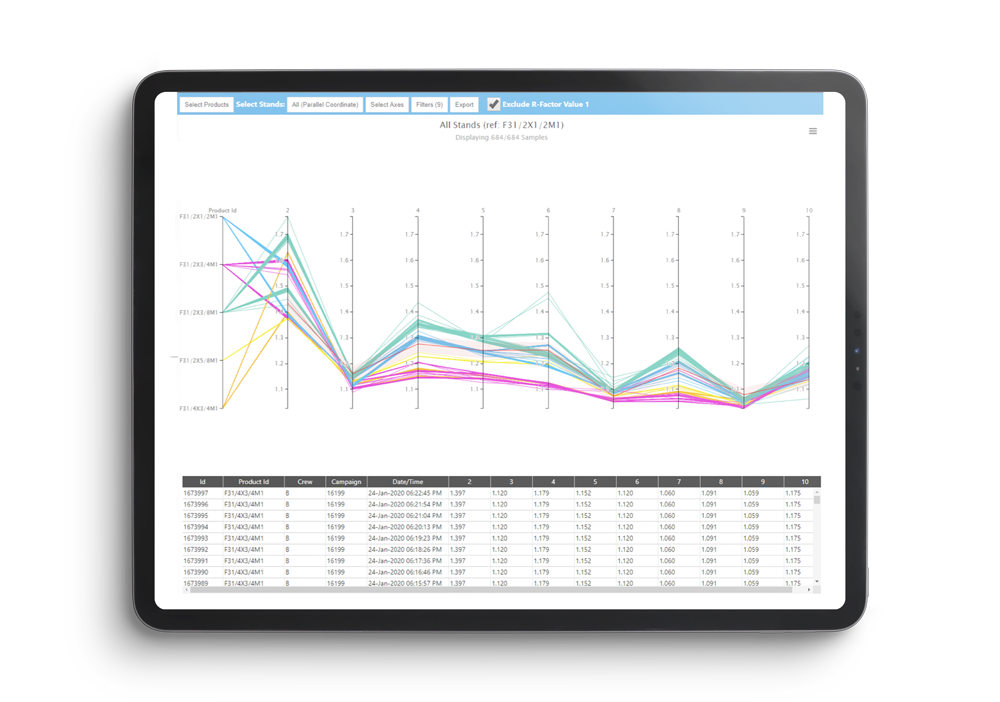A fully automated rolling mill process control feedback system designed for your operators to safely increase productivity in long product continuous mills.
QMOS R-Factor System
Safely Increase Production by removing the Operator from the “line of fire” when measuring hot bars

Improve Safety
Reduce the need to physically measure hot bars

Reduce Cobbles
By reducing variations that result in random & unexplained cobbles

Increase Production
By quicker "achieve section times" and fewer sizing delays

Increase Yield
By timely pass wear adjustments that reduce needless variations resulting in cobbles & off-spec bars

Quick & Easy Deployment
Real Time System with seamless integration to QMOS MES

Quick ROI
Pays for itself in months through significant yield improvements & sustainable production practices. Cobble rates have been cut in half with reported yield increases over 1% and shift utilization increases over 3%.
Overview
The QMOS R-factor System (QRFS) clearly shows the operators on the mill floor how the mill is set up and running, compared to the setup sheet. Roll gap (and other mill adjustments) can be made to bring the product into spec at each mill stand, then monitored for timely roll pass wear adjustments. This helps maintain the bar size throughout the entire rolling, greatly reducing cobbles and off spec bars, which delivers yield improvements.
QRFS trending shows if there is any crew-to-crew or rolling-to-rolling variation. Root cause analysis can determine corrective action such as modifying the pass design, correcting setup sheets or Training to reduce needless operating variation.
QRFS is a Real Time Process Control System that Safely Increases Production while reducing cobbles and increasing Yield.
Success requires covering all the bases:
Training • R-factor System • Pass Design Revisions • Shift assistance
Background
A steel mill provides a harsh and dangerous environment where it is very difficult and time consuming to measure the hot bar size accurately. In order for the rolling mill process to work properly, the Operator must know how the stand mill stand gaps are actually set. Traditionally this information is obtained by having the operator measure the hot moving bar with a set of calipers. This places the Operator beside the equipment while in operation, putting the Operator into the direct “line of fire” of the hot moving bar.
The electrical speed control system uses a speed matching algorithm along with operator input to set up a tension free condition in the bar between the continuous mill stands. Based on the speed control algorithm, it is possible to use this information, presented in a form the operator can utilize, to estimate the work done on the bar at each pass. This makes it possible for the operator to monitor changes in the bar size (work done) at each stand and determine when the mill stands should be adjusted to compensate for roll pass wear.
The QMOS R-factor System automates this data gathering process and presents the results to the operator in a timely, easy to read graph that shows how the mill is currently set up. The results for each bar rolled are stored in the QMOS database, allowing long term trends to be analyzed.
Rolling results & trends are analyzed to identify variation & production improvement opportunities. Take Action to reduce Variation, then confirm that variation is reduced.

R-Factors Show the Mill Setup
R-Factors show how the bar is being worked
• now (last bar rolled & current bar in the mill)
• in the past (trend last 1000 billets of current product)
Interpretation allows for:
• Temporary Changes to improve the shift
• Long term changes to resolve a technical issue
• Identifies setup sheets (data) or system errors (design)
Follow up & persistence allows for continuous improvement
Preconceived ideas can be challenged and better understood, changed or discarded as needed



